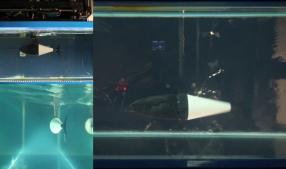
Did you know that a tuna is a super swimmer?
“They’re really fast, they’re really strong, they’re big, they’re at the top of their food chain without any natural predators. They’re a model organism for roboticists because they’re phenomenal swimmers,” said Daniel Quinn, University of Virginia assistant professor of Mechanical and Aerospace Engineering and Electrical and Computer Engineering and director of the Smart Fluid Systems Lab. “Besides being fast, tuna dart back and forth very quickly — complex, high-speed maneuvers — and we’re not sure how they do it.”
Quinn received a CAREER Award from the National Science Foundation to find out. The award is one of the nation’s most prestigious grants for early-career faculty who have the potential to serve as academic role models in research and education and to lead advances in the mission of their department or organization.
Quinn’s lab is using a tuna model rigged up to “swim” inside a tank to try to discover how liquids flow past the fish — a process called fluid dynamics — and govern high-speed, irregular or “asymmetric” swimming. By mapping out these flows, bio-inspired roboticists who have to rely on models of low-speed, regular or “symmetric” movements when designing and testing robots, will have the information they need to start modeling and designing fast, highly maneuverable water and aerial drones. Even though Quinn is studying swimming, the principles of fluid dynamics apply to water and air propulsion, so his research will inform both.
“We’ll be creating the first-ever flow visualizations of bio-inspired robots darting side-to-side,” Quinn said. “Our measurements could lay the groundwork for a new generation of intelligent swimming and flying machines.
“Part of the promise of these small, cheap vehicles is that they can be used en masse. Schools of tiny drones will be able to help with things like search and rescue, terrain mapping, or weather or climate tracking — all without disturbing the environment. They’ll let us study ecosystems in ways that aren’t currently possible with big, bulky propeller-driven vehicles, and they’ll help us to be better stewards of the natural world by reducing our footprint as we do our research,” he said.
Quinn’s test rig is highly sophisticated. The large, rectangular tank is a real water channel that houses a robotic tuna able to swim at a speed of 7 hertz, which means beating its tail seven times per second.
“There are two unique aspects to this rig,” Quinn said. “One, you can swim extremely fast, and two, you can move back and forth to maneuver.
“If you’re going to go super-fast, it’s really important that you can steer!” Quinn said. “In the natural world, you can’t do repeatable experiments on turning, since fish never turn the same way twice. The test rig gives us a controlled environment where we can produce and analyze turns in a repeatable way—it’s the only way to guarantee we’re uncovering the true physics of turning.”
Quinn’s team has also created artificial tendons for the tail fin of the robotic test fish so they can discover why and how “tail tensioning” affects swimming.
